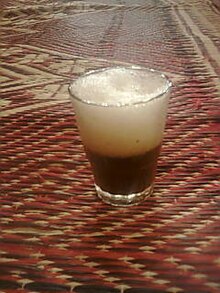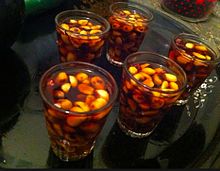
A cappuccino is an espresso-based coffee drink that is traditionally prepared with steamed milk including a layer of milk foam.

Caffè latte, often shortened to just latte in English, is a coffee drink of Italian origin made with espresso and steamed milk, traditionally served in a glass. Variants include the chocolate-flavored mocha or replacing the coffee with another beverage base such as masala chai, mate, matcha, turmeric or rooibos; alternatives to milk, such as soy milk, almond milk or oat milk, are also used.

Maghrebi mint tea, also known as Moroccan mint tea and Algerian mint tea, is a North African preparation of gunpowder green tea with spearmint leaves and sugar.

Tea culture is defined by how tea is made and consumed, how people interact with tea, and the aesthetics surrounding tea drinking.

Arab cuisine is the cuisine of the Arab world, defined as the various regional cuisines of the Arab people, spanning from the Maghreb to the Mashriq. These cuisines are centuries old and reflect the culture of trading in ingredients, spices, herbs, and commodities. The regions have many similarities, but also unique traditions. They have also been influenced by climate, cultivation, and mutual commerce.

Tatar cuisine is primarily the cuisine of the Volga Tatars, who live in Tatarstan, Russia, and surrounding areas.

Yemeni cuisine is distinct from the wider Middle Eastern cuisines, but with a degree of regional variation. Although some foreign influences are evident in some regions of the country, the Yemeni kitchen is based on similar foundations across the country.
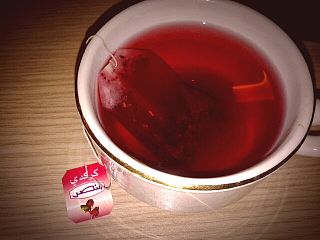
Hibiscus tea is a herbal tea made as an infusion from crimson or deep magenta-colored calyces (sepals) of the roselle flower. It is consumed both hot and cold. It has a tart, cranberry-like flavor.

Egyptian cuisine makes heavy use of poultry, legumes, vegetables and fruit from Egypt's rich Nile Valley and Delta. Examples of Egyptian dishes include rice-stuffed vegetables and grape leaves, hummus, falafel, shawarma, kebab and kofta. Others include ful medames, mashed fava beans; koshary, lentils and pasta; and molokhiyya, bush okra stew. A local type of pita bread known as eish baladi is a staple of Egyptian cuisine, and cheesemaking in Egypt dates back to the First Dynasty of Egypt, with Domiati being the most popular type of cheese consumed today.

Sfenj is a Maghrebi doughnut: a light, spongy ring of dough fried in oil. Sfenj is eaten plain, sprinkled with sugar, or soaked in honey. It is a well-known dish in the Maghreb and is traditionally made and sold early in the morning for breakfast or in the late afternoon accompanied by tea—usually Maghrebi mint tea—or coffee. The term Sfenj is used in Algeria and other parts of the Maghreb. It is called bambalouni in Tunisia, and Sfenj in Libya. In Morocco, the term "Sfenj" is used, also sometimes nicknamed in the literature "Moroccan doughnuts". It is also called Khfaf or ftayr in Algeria, and is sometimes also dubbed as the "Algerian doughnut".
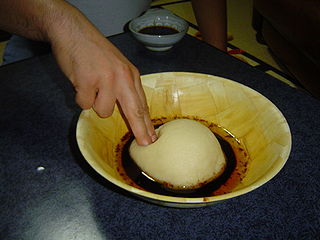
The cuisine of Libya is a mix of Berber, Arab and Mediterranean cuisines with Ottoman and Italian influence. One of the most popular Libyan dishes is bazin, an unleavened bread prepared with barley, water and salt. Bazin is prepared by boiling barley flour in water and then beating it to create a dough using a magraf, which is a unique stick designed for this purpose.

Doodh pati chai is a tea beverage, originating from the Indian subcontinent, consumed in India, Pakistan, Bangladesh, Afghanistan and Nepal in which milk, together with sugar, is boiled with tea. Doodh pati is different from saada chai, in that it only uses milk and tea. This tea is quite common in South Asia. It is marginally costlier than the regular, water-based saada chai.

Mate cocido, chá mate, kojoi, or yerbiado is an infusion typical of Southern Cone cuisine. It is traditionally prepared by boiling yerba mate in water, then strained and served in cups. It is a bitter tasting beverage, similar to mate but milder, with the same stimulating and nutritional properties. It is also sold in teabags, so it can be prepared like tea.
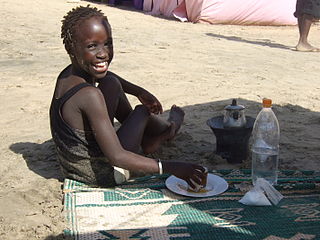
Senegalese tea culture is an important part of daily social life. The Senegalese tea-drinking custom is essentially similar to those of other countries in the West Africa region, such as Mali, Guinea, Gambia and Mauritania. In and around Senegal, tea is prepared and presented in an elaborate process, and known in the Wolof language as attaya, ataya or ataaya.

Masala chai is a popular beverage throughout South Asia, originating in the early modern Indian subcontinent. Chai is made by brewing black tea in milk and water and then sweetening with sugar. Adding aromatic herbs and spices creates chai, although chai is often prepared unspiced.

A disposable cup is a type of tableware and disposable food packaging. Disposable cup types include paper cups, plastic cups and foam cups. Expanded polystyrene is used to manufacture foam cups, and polypropylene is used to manufacture plastic cups.

Arabic tea (Arabic: شاي عربي, romanized: šāy ʿarabiyy, (pronounced shay, is a variety of hot teas popular throughout the Arab world. It is commonly served to guests and business partners at meetings and social events, and has been drunk by Arab people for centuries.
